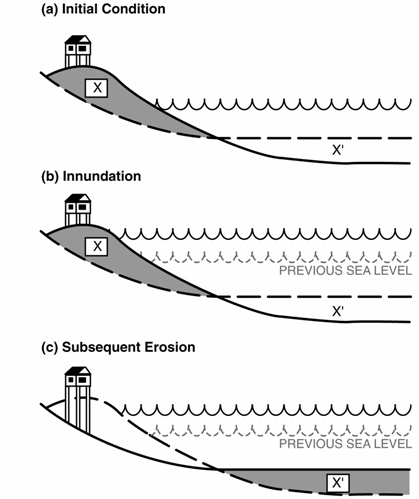- Causes of Future Sea Level Rise
- Elevation Maps
- Will we really lose all that land?
- Sea Level Rise Planning Maps
Erosion
Rising sea level inundates low-lying areas, converts wetlands to open water, erodes beaches, exacerbates flooding, and increases the salinity of estuaries and aquifers. Here are some reports that examine how shores may erode as sea level rises.
 The Bruun RuleA rise in sea level immediately results in shoreline retreat due to innundation, as
shown in (a) and (b). However, a one-meter rise in sea level implies that the offshore bottom must also
rise one meter. The sand requires to raise the bottom (X') can be supplied by bach nourishmemt. Otherwise,
the beach and dunes will supply that sand (X) as shown in (c). |
Rising sea level erodes beaches by more than the loss of land from inundation alone. Since 1962, coastal geologists and engineers have often used the Bruun Rule to explain why. The figure to the right shows the general idea. A rise in sea level directly inundates a relatively small portion of tbe beach (b). However, the cross section of a given beach tends to follow a given profile relative to the sea. As storm waves erode the beach and deposit sand nearby and the summer swell rebuilds the beach, the offshore area tends to retain a particular depth. As sea level rises, the nearshore bottom must rise as well to keep that profile and unless sand is brought in from elsewhere, the beach and dunes provide the land that elevates the bottom.
Some geologists dislike the Bruun Rule as a predictive tool, but whether it is a complete explanation of erosion caused by sea level rise, it is one of the best teaching tools because a simple reflection of the three boxes illustrate why shore erosion should be greater than just inundation alone.
Reports and other products
- Ocean Coasts summarizes what coastal scientists think about the impact of sea level rise on sandy shorelines. The article was a chapter in the Bush Administration's official literature review of the impacts of sea level rise entitled Coastal Sensitivity to Sea Level Rise: A Focus on the Mid-Atlantic Region - U.S. Climate Change Science Program (2009) The chapter does not quantify shoreline retreat from sea level rise, amd suggests that most previous efforts to do so were questionable at best. Nevertheless, it does offer predictions about which barrier island and spits are likely to cross an threshold from (generally) present-day stability to a future instability in which these coastal barriers disintegrate and/or reform well inland of their present locations.
- Anticipatory Planning for Sea-Level Rise Along the Coast of Maine - Maine State Planning Office and U.S. EPA, EPA- 230-R-95-900 (1995). The Maine Geological Survey predicted shore erosion caused by sea level rise along Saco and Casco Bays, with a particularly in-depth assessment of Camp Ellis
- The first nationwide assessment of the impacts of sea level rise. The primary focus of study was to estimate land loss, wetland loss, and the cost of holding back the sea, for inclusion in Chapter 7 from EPA's 1989 Report to Congress: Potential Effects of Global Climate Change on the United States EPA-230-05-89-052 (1989) About one third of the study's budget was on Stephen Leatherman's estimate of the nationwide cost of beach nourishment to counteract the shore erosion that would otherwise occur. The study used the the "raised the beach profile" method, which is largely consistent with the Brrun Rule. While laying out the rationale for that approach, the overview paper also warns that the accuracy of the approach depends completely on correctly estimating the area of the beach profile that must be elevated, which depends on storms and also is greater in the long run than the short run.
- Greenhouse Effect and Sea Level Rise: The Cost of Holding Back the Sea - Coastal Management, 19:171-204 (Abstract), (html), (pdf) (1991). This article summarizes the sea level rise study conducted for the Report to Congress.
- Greenhouse Effect, Sea Level Rise, and Barrier Islands: Case Study of Long Beach Island, New Jersey - Coastal Management, 18:65-90 (1990) (html). Mostly about the various response strategies but also includes a discussion of barrier island migration and a graphic illustrating how the logic of the Bruun Rule might apply to barrier islands
- Potential Impacts of Sea Level Rise on the Beach at Ocean City, Maryland - U.S. EPA (1985). The authors use various methods to estimate the shore erosion caused by sea level rise along the Atlantic shore of Ocean City, Maryland
- Galveston Bay Case Study by Stephen P Leatherman (1984) in Greenhouse Effect and Sea Level Rise: A Challenge for this Generation. Estimates future erosion for shores along Gavleston Bay.
- Charleston Case Study by Tim Kana et al. (1984) in Greenhouse Effect and Sea Level Rise: A Challenge for this Generation. Estimates future erosion due to sea level rise along Sullivans Island using the Bruun Rule, and creates maps that consider both erosion caaused by sea level rise and shoreline accretion caused by other factors
- Rising Seas, Coastal Erosion, and the Takings Clause: How to Save Wetlands and Beaches Without Hurting Property Owners - Maryland Law Review, Volume 57, 1279-1399 (1998). Explores how to keep shore erosion from eliminating estuarine beaches given the tendency to erect shore protection structures
